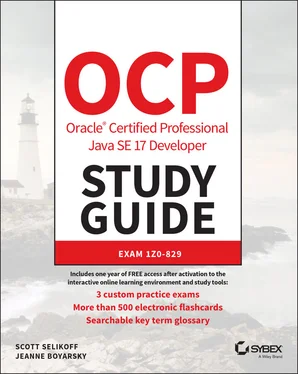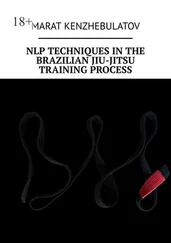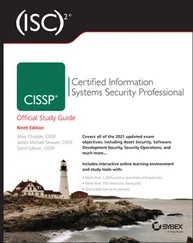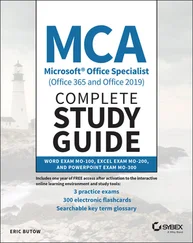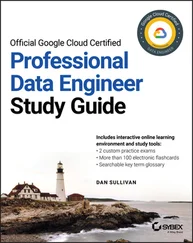11 Chapter 10TABLE 10.1 Common Optionalinstance methodsTABLE 10.2 Intermediate vs. terminal operationsTABLE 10.3 Creating a sourceTABLE 10.4 Terminal stream operationsTABLE 10.5 Common primitive stream methodsTABLE 10.6 Mapping methods between types of streamsTABLE 10.7 Function parameters when mapping between types of streamsTABLE 10.8 Optional types for primitivesTABLE 10.9 SpliteratormethodsTABLE 10.10 Examples of grouping/partitioning collectors
12 Chapter 11TABLE 11.1 Types of exceptions and errorsTABLE 11.2 Unchecked exceptionsTABLE 11.3 Checked exceptionsTABLE 11.4 ErrorsTABLE 11.5 DecimalFormatsymbolsTABLE 11.6 Common date/time symbolsTABLE 11.7 Supported date/time symbolsTABLE 11.8 Factory methods to get a NumberFormatTABLE 11.9 Factory methods to get a DateTimeFormatterTABLE 11.10 Locale.CategoryvaluesTABLE 11.11 Picking a resource bundle for French/France with default locale ...TABLE 11.12 Selecting resource bundle properties
13 Chapter 12TABLE 12.1 Options you need to know for using modules with javacTABLE 12.2 Options you need to know for using modules with javaTABLE 12.3 Access control with modulesTABLE 12.4 Reviewing servicesTABLE 12.5 Reviewing directivesTABLE 12.6 Common modulesTABLE 12.7 Java modules prefixed with javaTABLE 12.8 Java modules prefixed with jdkTABLE 12.9 Modes using jmodTABLE 12.10 Comparing command-line operationsTABLE 12.11 Options you need to know for the exam: javacTABLE 12.12 Options you need to know for the exam: javaTABLE 12.13 Options you need to know for the exam: jarTABLE 12.14 Options you need to know for the exam: jdepsTABLE 12.15 Options you need to know for the exam: jlinkTABLE 12.16 Practicing with automatic module namesTABLE 12.17 Properties of module typesTABLE 12.18 Comparing migration strategies
14 Chapter 13TABLE 13.1 ExecutorServicemethodsTABLE 13.2 FuturemethodsTABLE 13.3 TimeUnitvaluesTABLE 13.4 ScheduledExecutorServicemethodsTABLE 13.5 Executorsfactory methodsTABLE 13.6 Atomic classesTABLE 13.7 Common atomic methodsTABLE 13.8 LockmethodsTABLE 13.9 Concurrent collection classesTABLE 13.10 Synchronized Collectionsmethods
15 Chapter 14TABLE 14.1 File-system symbolsTABLE 14.2 Options for creating Fileand PathTABLE 14.3 Common Fileand PathoperationsTABLE 14.4 Common Fileand FilesoperationsTABLE 14.5 Common NIO.2 method argumentsTABLE 14.6 PathAPIsTABLE 14.7 The java.ioabstract stream base classesTABLE 14.8 The java.ioconcrete I/O stream classesTABLE 14.9 Common I/O read and write methodsTABLE 14.10 Common FilesNIO.2 read and write methodsTABLE 14.11 Common I/O stream methodsTABLE 14.12 The attributes and view typesTABLE 14.13 Walking a directory with a cycle using breadth-first searchTABLE 14.14 Key APIs
16 Chapter 15TABLE 15.1 CRUD operationsTABLE 15.2 SQLTABLE 15.3 SQL runnable by the executemethodTABLE 15.4 Return types of executemethodsTABLE 15.5 PreparedStatementmethodsTABLE 15.6 ResultSet getmethodsTABLE 15.7 Sample stored proceduresTABLE 15.8 Stored procedure parameter typesTABLE 15.9 ConnectionAPIs for transactions
1 Chapter 1 FIGURE 1.1 Compiling with packages FIGURE 1.2 Compiling with packages and directories FIGURE 1.3 Text block FIGURE 1.4 Your drawing after line 5 FIGURE 1.5 Your drawing after line 7
2 Chapter 2 FIGURE 2.1 Java operation FIGURE 2.2 The logical truth tables for &, |, and ^
3 Chapter 3 FIGURE 3.1 The structure of an ifstatement FIGURE 3.2 The structure of an elsestatement FIGURE 3.3 The structure of a switchstatement FIGURE 3.4 The structure of a switchexpression FIGURE 3.5 The structure of a whilestatement FIGURE 3.6 The structure of a do/ whilestatement FIGURE 3.7 The structure of a basic forloop FIGURE 3.8 The structure of an enhanced for-each loop FIGURE 3.9 The structure of a breakstatement FIGURE 3.10 The structure of a continuestatement
4 Chapter 4 FIGURE 4.1 Indexing for a stringFIGURE 4.2 Indexes for a substringFIGURE 4.3 The basic structure of an arrayFIGURE 4.4 An empty arrayFIGURE 4.5 An initialized arrayFIGURE 4.6 An array pointing to stringsFIGURE 4.7 A sparsely populated multidimensional arrayFIGURE 4.8 An asymmetric multidimensional arrayFIGURE 4.9 Period formatFIGURE 4.10 How daylight saving time works
5 Chapter 5FIGURE 5.1 Method declarationFIGURE 5.2 Classes used to show privateand package accessFIGURE 5.3 Classes used to show protected accessFIGURE 5.4 Copying a reference with pass-by-value
6 Chapter 6FIGURE 6.1 Subclass and superclass declarationsFIGURE 6.2 Types of inheritanceFIGURE 6.3 Java object inheritance
7 Chapter 7FIGURE 7.1 Defining an interfaceFIGURE 7.2 Implementing an interfaceFIGURE 7.3 Interface InheritanceFIGURE 7.4 Defining a simple enumFIGURE 7.5 Defining a sealed classFIGURE 7.6 Defining a recordFIGURE 7.7 Declaring a compact constructorFIGURE 7.8 Object vs. reference
8 Chapter 8FIGURE 8.1 Lambda syntax omitting optional partsFIGURE 8.2 Lambda syntax including optional parts
9 Chapter 9FIGURE 9.1 Java Collections FrameworkFIGURE 9.2 Example of a ListFIGURE 9.3 Example of a SetFIGURE 9.4 Examples of a HashSetand TreeSetFIGURE 9.5 Example of a DequeFIGURE 9.6 Working with a DequeFIGURE 9.7 Working with a stackFIGURE 9.8 Example of a Map
10 Chapter 10FIGURE 10.1 OptionalFIGURE 10.2 Stream pipelineFIGURE 10.3 Steps in running a stream pipelineFIGURE 10.4 A stream pipeline with a limitFIGURE 10.5 Stream pipeline with multiple intermediate operations
11 Chapter 11FIGURE 11.1 Categories of exceptionFIGURE 11.2 The syntax of a trystatementFIGURE 11.3 The syntax of a multi-catch blockFIGURE 11.4 The syntax of a trystatement with finallyFIGURE 11.5 The syntax of a basic try-with-resources statementFIGURE 11.6 Localeformats
12 Chapter 12FIGURE 12.1 Design of a modular systemFIGURE 12.2 Looking inside a moduleFIGURE 12.3 Contents of zoo.animal.feedingFIGURE 12.4 Module zoo.animal.feedingdirectory structureFIGURE 12.5 Running a module using javaFIGURE 12.6 Modules depending on zoo.animal.feedingFIGURE 12.7 Contents of zoo.animal.careFIGURE 12.8 Dependencies for zoo.animal.talksFIGURE 12.9 Contents of zoo.animal.talksFIGURE 12.10 Contents of zoo.staffFIGURE 12.11 Dependencies for zoo.staffFIGURE 12.12 Transitive dependency version of our modulesFIGURE 12.13 Modules in the tour applicationFIGURE 12.14 Determining the orderFIGURE 12.15 Determining the order when not uniqueFIGURE 12.16 Bottom-up migrationFIGURE 12.17 Top-down migrationFIGURE 12.18 First attempt at decompositionFIGURE 12.19 Removing the cyclic dependencies
13 Chapter 13FIGURE 13.1 Process modelFIGURE 13.2 Thread statesFIGURE 13.3 ExecutorServicelife cycleFIGURE 13.4 Lack of thread synchronizationFIGURE 13.5 Thread synchronization using atomic operationsFIGURE 13.6 Race condition on user creation
14 Chapter 14FIGURE 14.1 Directory and file hierarchyFIGURE 14.2 Relative paths using path symbolsFIGURE 14.3 I/O and NIO.2 class and interface relationshipsFIGURE 14.4 Comparing file uniquenessFIGURE 14.5 Visual representation of an I/O streamFIGURE 14.6 Serialization processFIGURE 14.7 File system with cycleFIGURE 14.8 Diagram of I/O stream classes
Читать дальше
